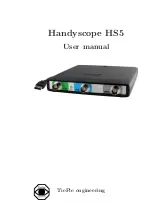
The higher the
resolution
, the more levels are available and
the more accurate the input signal can be reconstructed. In figure
, the same signal is digitized, using two different amounts of
levels: 16 (4-bit) and 64 (6-bit).
Figure 3.5: The effect of the resolution
The Handyscope HS5 measures at e.g. 14 bit resolution (2
14
=16384
levels). The smallest detectable voltage step depends on the input
range. This voltage can be calculated as:
V oltageStep
=
F ullInputRange/LevelCount
For example, the 200 mV range ranges from -200 mV to +200
mV, therefore the full range is 400 mV. This results in a smallest
detectable voltage step of 0.400V/16384 = 24.41
µ
V.
3.4
Signal coupling
The Handyscope HS5 has two different settings for the signal cou-
pling: AC and DC. In the setting DC, the signal is directly coupled
to the input circuit. All signal components available in the input
signal will arrive at the input circuit and will be measured.
In the setting AC, a capacitor will be placed between the input
connector and the input circuit. This capacitor will block all DC
components of the input signal and let all AC components pass
through. This can be used to remove a large DC component of the
input signal, to be able to measure a small AC component at high
resolution.
Introduction
11
Summary of Contents for Handyscope HS5 series
Page 1: ...Handyscope HS5 User manual TiePie engineering...
Page 6: ...2 Chapter 1...
Page 17: ...Figure 3 6 correct Figure 3 7 under compensated Figure 3 8 over compensated Introduction 13...
Page 18: ...14 Chapter 3...
Page 24: ...20 Chapter 4...
Page 28: ...24 Chapter 5...
Page 30: ...26 Chapter 6...
Page 32: ...28 Chapter 7...
Page 46: ...42 Chapter 9...






























